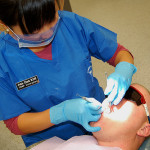Drugs or drugs capable of producing sedation or general anesthesia may be administered by the inhaled route, intravenous, intramuscular, oral or rectal (14). The use of one of these paths not exclude the other. The arsenal of drugs available to the anesthetist dentist in Chicago which is wide and varied, may be employed in conjunction with one inhalation anesthetic intravenously or intramuscularly.
STAGES OF GENERAL ANESTHESIA
- PREVIOUS ANESTHESIA MEDICATIONS OR Preanesthesia: involves the administration of drugs or drugs in the preoperative period, designed to reduce anxiety, facilitate anesthesia and minimize complications and / or side effects. This stage could be dispensed with, since in some opportunities may not be indicated.
- ANESTHESIA INDUCTION: The phase of general anesthesia characterized by loss of consciousness and other states such as fear, anxiety, distress etc. This stage involves the administration of drugs, tracheal intubation, which can be bucotraqueal or nasotracheal (15) and the achievement of a proper surgical plane. Meanwhile the tracheal intubation is a procedure that allows the administration of anesthetics and oxygen inhalation, without the risk of passage of liquid blood or other bronchial tree, but not a risk-free practice, since it can produce: pharyngitis and tracheitis, injury turbinates and nasal mucosa, granuloma of the vocal cords and cardiovascular disorders such as hypertension, tachycardia and arrhythmias. In most interventions maxillofacial surgery and dentistry, nasotracheal intubation is preferred to allow free oral field.
- MAINTENANCE OF ANESTHESIA: After reaching the proper surgical plane, it must be maintained, for it is used inhaled drugs such as nitrous oxide, halogenated gases as Ethrane, Halothane, Isoflurane, Sevoflurane, Intravenous anesthetics such as propofol, etomidate , Ketamine, Fentanyl, Alfentanil, Sufentanil, etc.. During maintenance of anesthesia requires continuous monitoring of vital parameters such as blood pressure, heart rate and rhythm, oxygen saturation, expired carbon dioxide, etc..
- RECOVERY: Upon completion of the surgery, and suspended the administration of anesthetic drugs, begins the recovery process, which is just go the opposite way to the awakening of the patient. The readiness to achieve recovery will depend on the drugs used during induction and maintenance of anesthesia, the dose and the characteristics of the metabolism and elimination. At this stage the patient monitoring to be high, to avoid potential complications of hypoventilation, pain, arrhythmias, nausea or vomiting. The patient’s recovery must be complete before his departure, when it comes outpatient anesthetic procedures, as the patient in this case graduates at home and not a hospital service.
